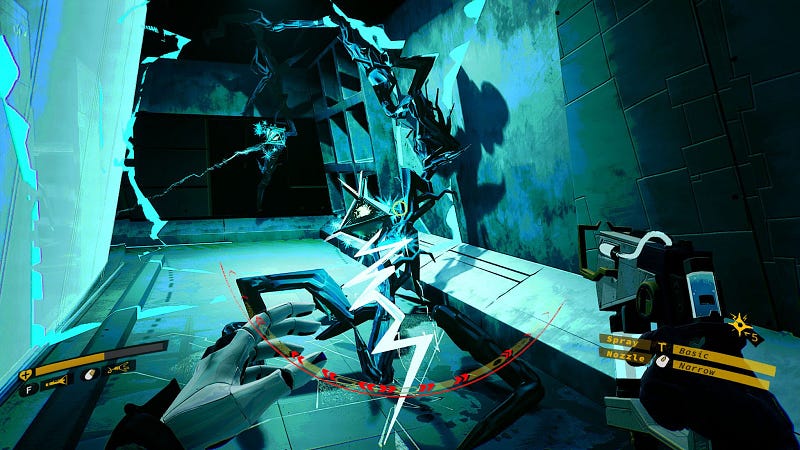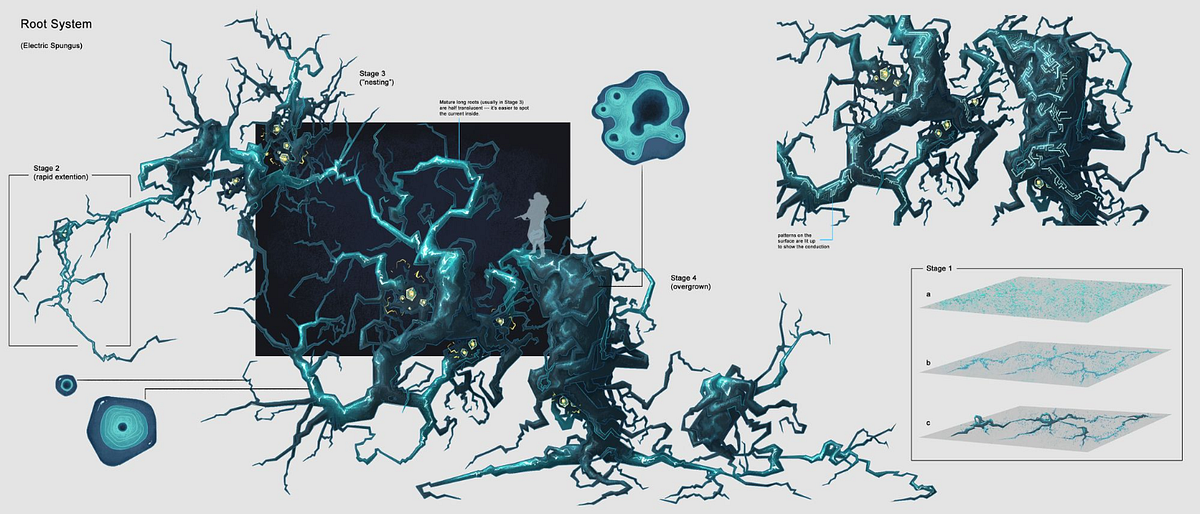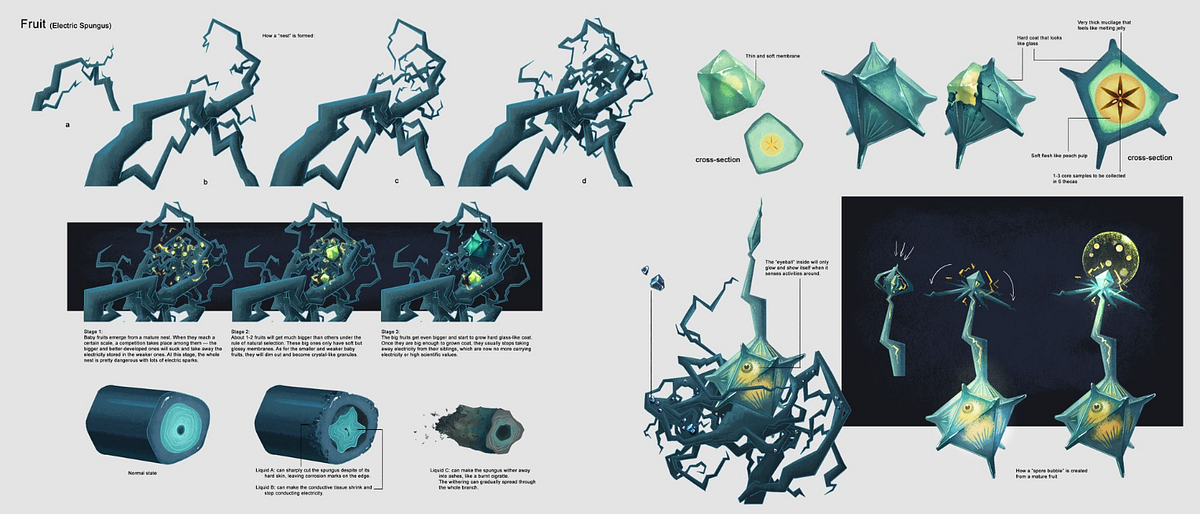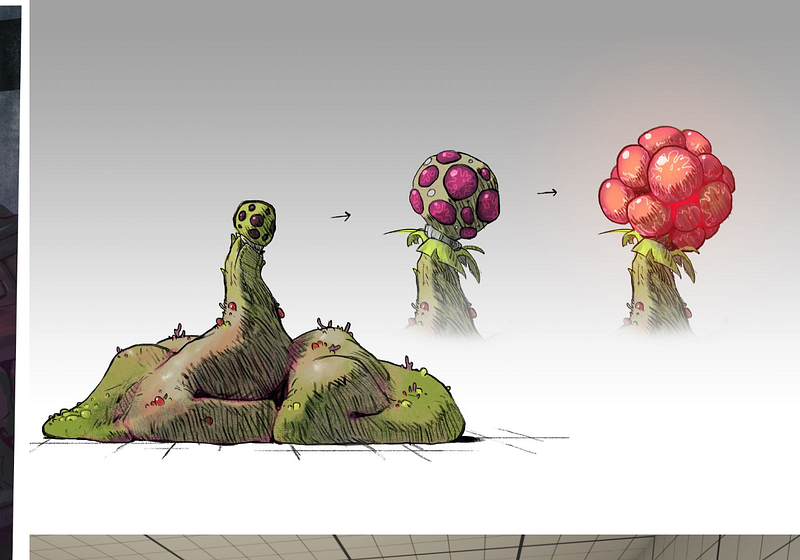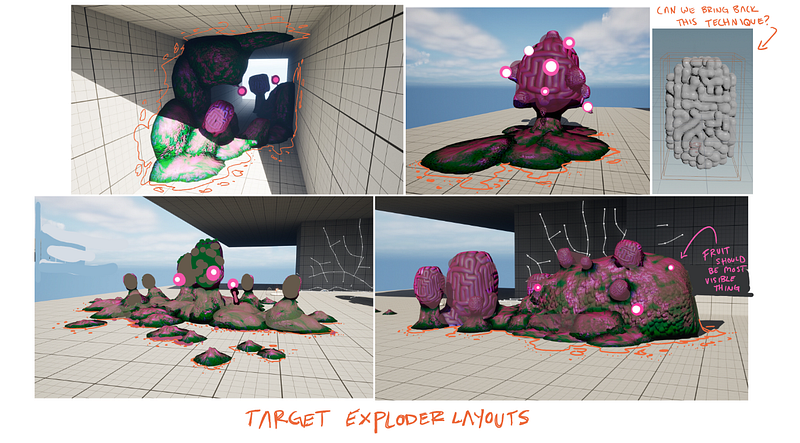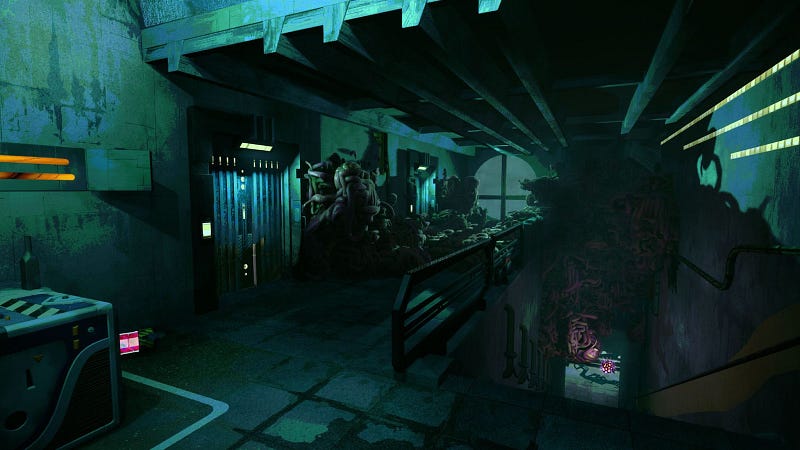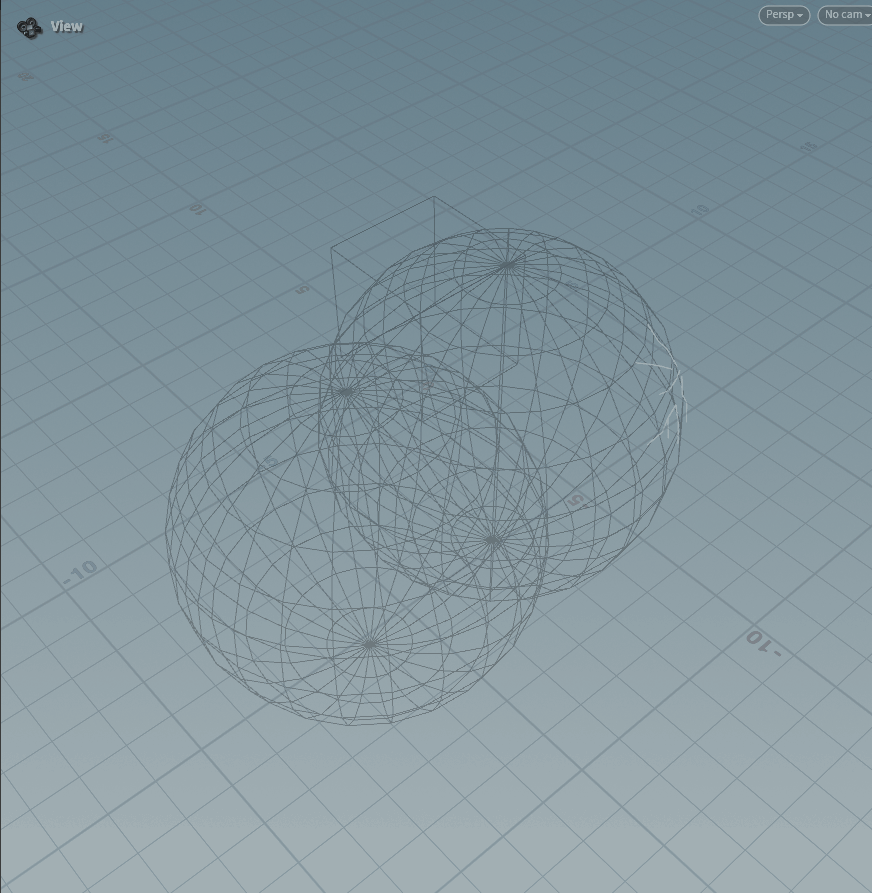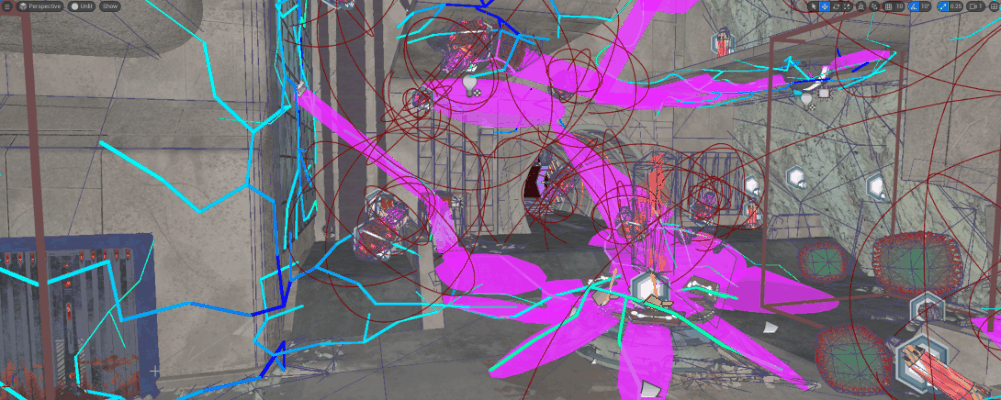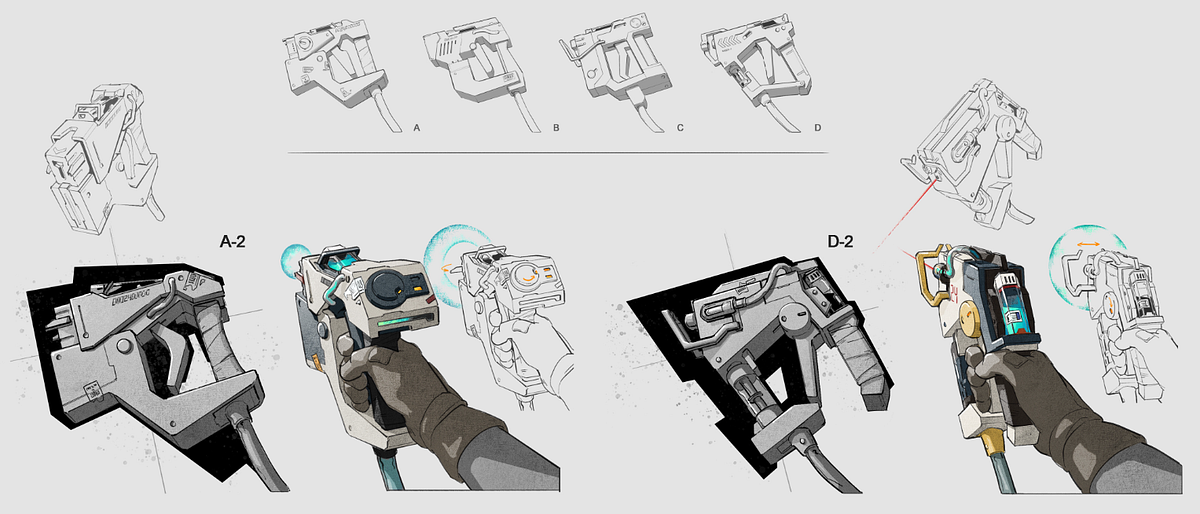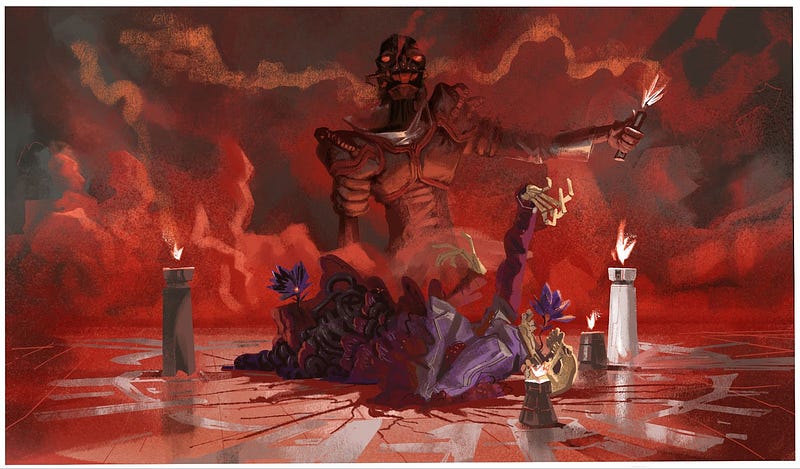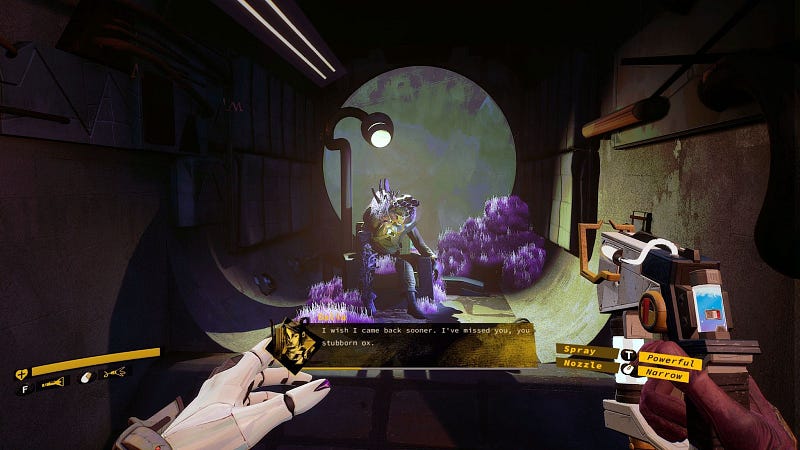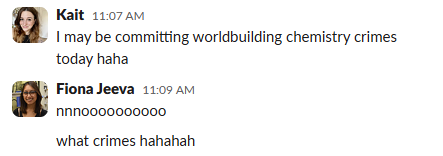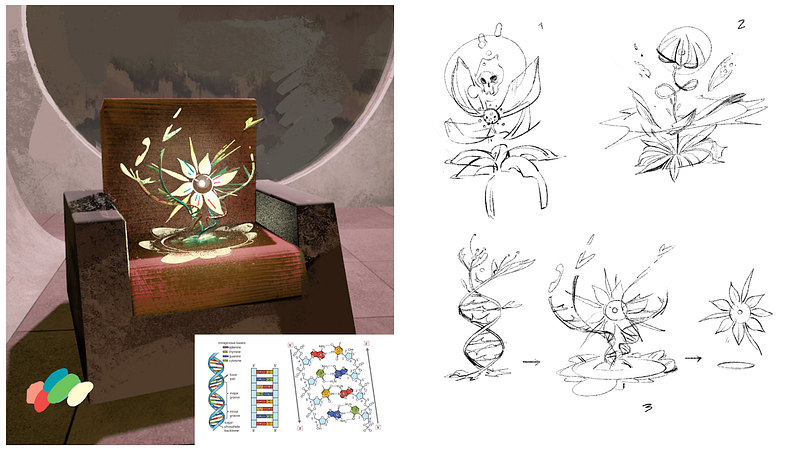
Ambrosia Sky is a first-person immersive sim where the only thing standing between you and the answers you seek are treacherous zero-G anomalies, deadly alien fungus with their own unique abilities, and the creeping guilt that maybe if you hadn’t abandoned this place all those years ago, everyone you used to know might still be alive.

Ambrosia Sky: Act One will be your sombre homecoming to a colony that is overrun with a vibrant, alien ecosystem. Adapt and survive encounters with various forms of hostile fungi that will burn, electrocute, and overwhelm you. Harvest their fruit to craft powerful new chemical agents to fight back or open new avenues of exploration. And pick through the desiccated remains of a once populous colony as you journey into strange depths to unravel the dark mystery that left its inhabitants dead, missing, or maybe even complicit.
Ambrosia Sky’s unique gameplay blends rewarding exploration with meditative cleaning. Use your chemical sprayer to cleanse unique strains of deadly fungi, each one trying to burn, electrocute, or trap you. Study their behaviours and harvest their fruiting bodies to craft powerful upgrades, like electrical foam you can use to reroute power to power doors or consoles.
The stylized world of Ambrosia Sky is a living ecosystem with both the hostile fungus and the remnants of those who once lived there. Explore a series of environments across a range of mission types, using your tether to traverse unstable gravity fields or reach hidden passages to uncover the mystery of the Cluster.
Your mission isn’t purely personal. As part of an enigmatic order of scientists in pursuit of human immortality, you are also tasked with finding victims of the contamination whose DNA can be studied. Find these chosen deceased, perform a sacred ritual to further your research and understand the disaster through the lives of the people destroyed by it.
ABOUT THE DEVELOPMENT TEAM
Soft Rains is a Toronto, Canada-based game studio focused on delivering world-class development experience in our work, from world-building and memorable storytelling to immersive gameplay and art.
 Hello Scarabs!
Hello Scarabs!
Thank you to everyone who has played the demo for Ambrosia Sky since its launch in June! We are grateful to everyone who played it, posted about it, told their friends to download it, and to all the folks who shared their thoughts, feedback, and bug reports.
If you've visited The Cluster before or if it is your first time, you'll find a smoother & expanded demo build that is now available to check out. Here's what you can expect in the latest update:
A new location representing a new mission type
[/*]Improved fungus variety
[/*]Fully voice-acted main character and death ritual scenes
[/*]Overhauled crafting & progression
[/*]Location revisit systems (a cleaning meter tracking the total percentage of the location cleaned)
[/*]Hidden collectibles
[/*]General gameplay and core loop polish
[/*]Bug fixes
[/*]
Check out what's new in the demo, and head on over to our Discord to let us know what you think! (Or if you run into any bugs!)
[hr][/hr]
Our demo works on the Steam Deck*!
Although our demo hasn't undergone rigorous official testing for compatibility, we've found it to work quite well on the Deck and wanted to share that information with you!
Of course, there may be some weirdness/small text that can occur - but please let us know your experience with the demo on the Deck and other platforms! We are working hard to ensure the game runs well on the go.
*and other PC handheld platforms, probably
[hr][/hr]If you can't play the demo or want something on your second screen while you work, may I offer you a developer demo playthrough video during these trying times?
Join narrative director Kait Tremblay and community manager Colin Cummings as they play through the latest build, talk worldbuilding, and chat about what the fungus might taste like.
Thank you for reading our latest update! If you haven't added the game to your wishlist or downloaded the demo, here's your sign to do both!
https://store.steampowered.com/app/3580160/Ambrosia_Sky/
See you in the stars,
Colin
\[Community Manager]

Community Update #1 / October 2025
Welcome to the very first community update for our upcoming title, Ambrosia Sky. These updates will be semi-regular and will highlight streams, videos, press coverage, and other minor updates related to the game. Since this is our first one, we've got a few things to catch up on, so without further ado...

Don't miss IGN Nextfest!

Ambrosia Sky is part of IGN Fanfest!
Tune in on October 15th to learn more about your upcoming trip to The Cluster, and discover what awaits you when you arrive...
Learn more here: https://www.ign.com/articles/ign-fan-fest-fall-2025-partner-lineup

Personality Quizzes, plural!
If you are dying to know which type of fungus you most closely align with, or if you're curious which of our main cast resonates with you, we've got two personality quizzes you can check out now!

We have created a quick and fun quiz to finally end your sleepless nights, wondering what type of fungus from our game you would be. It's like a Rorschach test, but the blobs are your results. Take the quiz here!
[carousel]



 [/carousel]
[/carousel]We've introduced you to our cast of characters (see Devlog 7 ), and now you can find out which character you are most like! Are you the protagonist, the enterprising ex, the ruthless stepmother, or our guy-in-the-chair? Find out with this quiz!

A wild Story Trailer appears!
In case you missed it, we recently shared a brand-new trailer that reveals more about why Dalia has come home to The Cluster and what she'll face upon arrival.
Did you know we have a Discord server?

Have you been playing the demo and want to share your thoughts or feedback? Do you want to ask our developers questions directly? Would you like to learn more about our world? If you have answered yes to any of those... we've got the Discord server for you! Come join us, the water is fine.
[h3]
[/h3]
Join us for a LIVE Developer Q&A!

Next Tuesday at 3pm ET, join Joel, Colin, and Sofy as they answer your questions and play through our latest demo build. Catch the stream at: https://twitch.tv/softrainsgames
The stream will also be archived on our YouTube channel. If you can't make the stream or would like to submit your question ahead of time, please feel free to drop your questions in the comments below.

That's it for our very first community update! We're nearing some major milestones that we'll discuss in more detail soon. If you haven't https://store.steampowered.com/app/3716830/Ambrosia_Sky_Demo/"" style="color:#bb86fc;text-decoration:none;">played the demo or wishlisted the game yet, this is your sign to do either or both!
https://store.steampowered.com/app/3580160/Ambrosia_Sky/
See you in the stars,
[i]Colin
\[Community Manager][/i]

Kaitlin Tremblay is the narrative director at Soft Rains. As a writer and narrative designer, theyve worked on games such as Grindstone (CAPY Game), Watch Dogs Legion (Ubisoft), A Morticians Tale, and others. They are the author of two non-fiction books on video games: Aint No Place for a Hero: Borderland s (ECW Press, 2017) and Collaborative Worldbuilding for Video Games (CRC Press, 2023).

The story of https://store.steampowered.com/app/3580160/Ambrosia_Sky/"" style="color:#bb86fc;text-decoration:none;">Ambrosia Sky is a homecoming tale, of Dalia returning to the asteroid colony where she was born, 15 years after she left in a huff. And as such, the other characters who inhabit this world are essential players in the story of Ambrosia Sky.
So, for this developer log on Ambrosia Sky, I wanted to take some time and talk about the other main characters in the game. Theres Maaz, Dalias Scarab partner and best friend. Theres Maeve, the estranged love of her life. And Hale, the overbearing stepmother. All of these characters play an important role, both in Dalias story, but also in the story of the Cluster & the story of the world Dalia left behind, the one that kept ticking without her.
Maaz, our man-in-the-van
While Dalia is technically alone on this job, shes not without support, in the form of a Scarab named Maaz. Maaz is Dalias man-in-the-van, acting as both her mission dispatch and her sample analyst. While Dalia is out in the field, shes dictating her notes to Maaz, which she uploads every time she returns to her shuttle. Maaz receives these observation notes and is able to provide delayed emotional support to Dalia, while also using the notes as crucial contextual information as he analyzes the samples Dalia sends to him while performing her job.

Maaz isnt just waiting for Dalias notes or samples, though. Despite their distance, Maaz has remote access to Dalias shuttle, so hes able to monitor nearby comms, signals, and alerts while Dalia is deep in the field. And while this is primarily a safety precaution to protect Dalia from stray asteroids, it also allows Maaz to scan for any signs of life and movement on the Cluster that could indicate not everybody is dead. A role that will become incredibly important for Dalias motivations while she explores the Cluster.
Maaz joined up with the Scarabs shortly before Dalia. A lighthearted and charismatic man born to wealthy colonists in one of the furthest galaxies, Maaz sought to join up with the Scarabs out of boredom. He was tired of the same socialite people, and, like Dalia, he wanted out from the controlling regimes of his parents. Due to his upbringing, Maaz is a man who is comfortable in his own skin and naturally puts others at ease. Maaz has nothing to prove and effortlessly finds himself as the life of the party. As a Scarab, Maaz is ambivalent about the panaceait could exist or it couldnt. What Maaz is really after, though, is learning everything there is to know about the exo-life that exists in the galaxy.

Its this background that makes Maaz an important and necessary foil to Dalia. When they meet, Maaz is fascinated by Dalia. Hes never met somebody from the Cluster before! And Dalia is at first put off by Maazs interest in her, but quickly accepts that he genuinely cares for her. Maazs affection for Dalia grows as he realizes she is the opposite of him in so many ways. They bond over their controlling parents, through both finding the Scarabs as a way to escape the life they dont want, and Maazs insistent presence becomes a comfort to Dalia. He doesnt want anything from her except for her friendship, and Dalia doesnt want anything from Maaz except for his. Whereas Dalia is this emotionally tumultuous person, Maaz is her rock. As one of the few people shes allowed herself to get close to since leaving her hometown, hes able to ground her, help her. Shell listen to him the way she wont listen to pretty much anybody else.
But the emotional grounding isnt the only reason we wanted to provide Maaz as a character. We knew we wanted Dalias experience and story to feel isolated, that her feeling of loneliness needed to be reinforced by her actual isolation on this journey. However, we still wanted a character to serve as a balance to her, both to provide moments of levity and to be a voice for the players. Since Dalia is from the Cluster, she isnt always able to call out whats strange. But its all new to Maaz, and so we wanted Maaz to be the voice that calls out the weird things Dalia might take for granted. Like sentient fungus. Like creatures that can change shape. Those sorts of things.
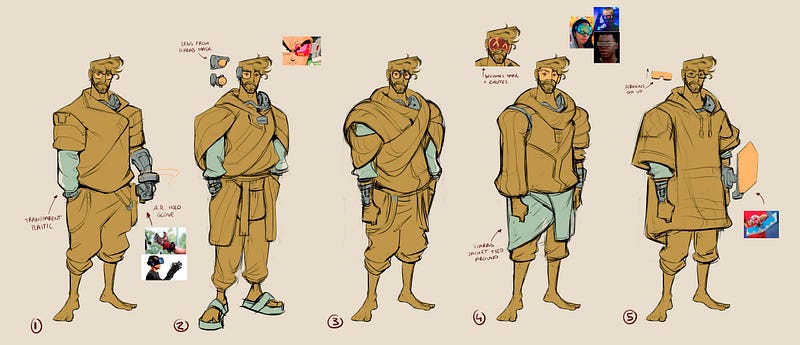
Developing Maaz was a lot of fun because of the way we envisioned him as a foil for Dalia. But we didnt just want him to be a stoic, solid rock of a best friend. We wanted him to be weird and to have his own perspectives, as well. Maaz, despite joining the Scarabs, has a weak stomach and is easily grossed out. And he has a fervent belief in sentient, humanoid alien life. Hes the Mulder to Dalias Scully, without the sexual tension. He wants to believe, and that includes believing in hot aliens, as well as in Dalia.

Maeve, the one who didntwait
And then theres Maeve, the reason for it all.
Maeve was Dalias best friend on the Cluster. Maeve was also the first person Dalia ever loved, despite Dalia never being able to tell Maeve this. Maeve and Dalia met as children in school, both studying agriculture from a young age. Dalia because Hale made her. Maeve, because she thought there was no other choice. However, Maeve was never good at their agricultural studies, despite Dalia excelling in them. Their differences bonded them together; Dalia helped Maeve with her studies, and Maeve became a confidante to Dalia. A lot of people kept their distance from Dalia on the Cluster, due to being the stepdaughter of the woman running the joint with an iron fist, but Maeve didnt care about that. Thick as thieves, the only thing that couldve broken Maeve and Dalia apart as teens was Dalia herself. So when Dalia left without warning at the age of 15 to become a Scarab, Maeve was hurt and furious. Both for Dalia abandoning her and for not even telling her she was going.
But Maeve refuses to wait for Dalias return and embraces her own reckless decisions. Since Dalias departure, Maeve has worked under Hale and become the beating heart of the Cluster, responsible for the communitys daily operations and welfare. While Maeve was never good with soil, she was always good with people and with numbers. She makes sure everybody is fed. She requisitions equipment for those who need it. She helps out at the clinic when its short-staffed. Maeve genuinely loves the Cluster, not for its history or mythos, but for the people who live there and make it what it is. Maeve is willing to work a thankless, stressful job if it means people on the Cluster can do what they need to do with less hassle.
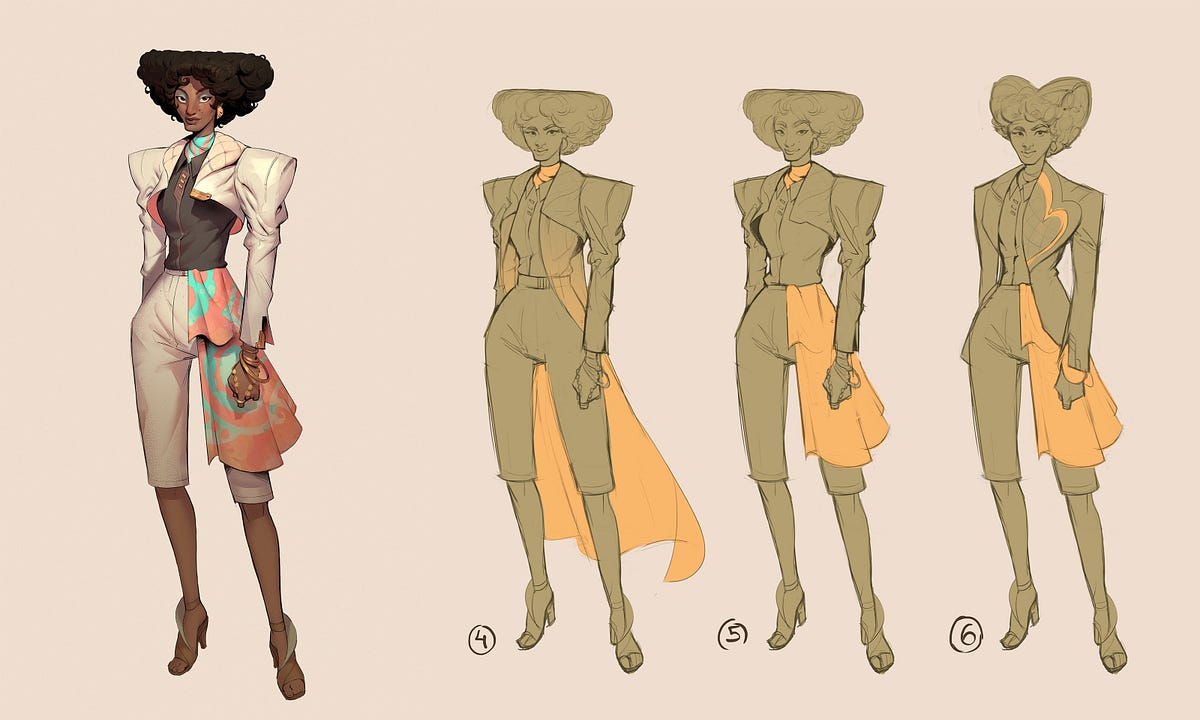
Maeves role in the story of Ambrosia Sky is one of the most important ones: shes the beacon of hope for Dalia. As Dalia begins to tailspin in her survivors guilt, Maeve being alive is the one thing that keeps her afloat. We wanted a reason for Dalia to stay at the Cluster when things got progressively worse throughout the game, and professionalism wasnt enough of a reason. Dalia left once before when things got too emotionally complicated for her; being here because shes on a job wouldnt be enough to keep her from peacing out yet again. So we knew we wanted a character who could be that lifeline for Dalia, the reason she would keep deciding to stay here even as her own life was threatened.
But I also didnt want Maeve to exist just for Dalia. I wanted her to be her own character, with her own goals, needs and ideas. Just because shes the lifeline for Dalia doesnt mean Maeve wants that role or fulfills it willingly. Throughout the game, Maeve is actively trying to find a cure for Clusterlung, the disease that has run rampant on the Cluster as a result of the fungal crisis. Maeve is her own character with her own goals, goals that often run counter to Dalias motivations. Maeve is helping the people of the Cluster evacuate. Maeve stayed while Dalia left, and so Maeve has devoted herself to caring for the people in her community, no matter what. Throughout Ambrosia Sky, players will learn about and track Maeves journey, discovering all of the ways in which Maeve was trying to make life better on the Cluster, and using her position as Hales right hand to do so.

And when Dalia arrives at the Cluster, Maeve doesnt change anything to meet her estranged friend. Maeve doesnt want Dalias help and resents her coming back now, only when things are at their worst. She stays focused on her goal: to cure Clusterlung. No matter the cost. And as Dalia will discover throughout Ambrosia Sky, that cost might be higher than she ever couldve imagined.

Hale, the controlling stepmother
With the people Dalia unquestionably loves introduced, lets talk about the person Dalia has the most complicated feelings about: her stepmother, Hale.
Hale Volkova is the de facto leader of the Cluster. A second-generation Clusterite, Hale came into power via her family name: Hales father, Doctor Volkov, was one of the founders of the Cluster. And as such, Hale has inherited power here. Hale loves the Cluster deeply. Not because she loves the people there like Maeve, but rather that she loves the power it affords her. She loves her status and her perception of herself above all else.

Ambrosia Sky needed a villain. With the main threats to Dalias physical safety being hostile fungus and creatures, we were feeling the lack of an emotional threat to Dalia. Since this story is about Dalias homecoming, what is the full range of that emotional landscape like? If Maeve is the reason for Dalia to stay, who is the reason for Dalia constantly wanting to leave? Her stepmother is perfect. Perfect because folklore was a huge inspiration for the worldbuilding of Ambrosia Sky, and the evil stepmother is a well-known trope from that type of storytelling, and playing with that trope sounded like so much fun to explore in a sci-fi setting. Perfect because it meant I got to write a trope I love.
Nobody else in the Cluster really likes Hale. To borrow a phrase, a lot of the agricultural residents on the Cluster believe shes all hat, no cattle, meaning she avoids getting her hands dirty doing the real, hard labour of working the fields. Shes also ruthless and believes shes larger than life because of her family name and position. Shes, frankly, insufferable, and I love that about her. Nobody believes in her importance the way Hale believes in her importance.
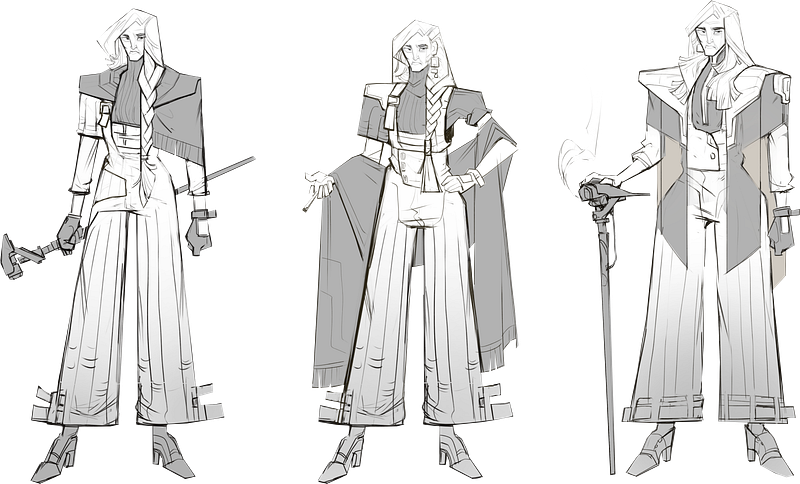
And its not that Hales is without complexity. Theres a reason she believes shes right, and thats because shes trying to run the colony in the best way that she can. She loves the Cluster, in part because it bestows power on her, but also because she was raised believing in the mythos of the Cluster. Her father was heroic, being one of the first pioneers to leave Earth to start building an agricultural colony to feed humanitys expansion into space. Hale was raised believing the Cluster mattersbecause it does. And protecting the Cluster, therefore, matters just as much. Despite the Clusters fall from grace as humanity settled farther and farther from Earth, Hale still believes in its mythos, and she will lie to protect it because she believes its necessary. In fact, she believes its her job to lie to protect people. Hale believes fundamentally that the Cluster should survive at all costs. But as the crisis worsens and threatens life on the Cluster, Hale realizes that Dalia may be the only one who can help her save the Cluster. Which complicates things for Hale, who is the person that Dalia learned how to handle her emotions from.

Hales a lot of fun to write. Shes emotionally ruthless while also being self-aggrandizing. If writing Dalia and Maeve is tapping into complex emotional landscapes of battling self-need with what we owe each other, Hale is the opposite: shes a person who unquestionably believes shes right. Its a pure, indulgent villain voice to write, and thats what the game needed to balance the heaviness of the other themes. Shes not cartoonish, but she does provide a space to vent some of the heaviness of grief and survivors guilt into just pure, indulgent anger.

If you want to know more about the development of Ambrosia Sky, take a look at our prior dev logs that cover our main character Dalia , the role of a Scarab , the art & audio direction of the game, a look at the tech & design behind our cleaning mechanics, and an overview of what Ambrosia Sky is.
You can also download the https://store.steampowered.com/app/3716830/Ambrosia_Sky_Demo/"" style="color:#bb86fc;text-decoration:none;">demo from Steam to step right into Dalias shoes and see the crisis firsthand. In our next devlog, well begin to talk about the cast of characters that surround and support Dalia on this journey.

Kaitlin Tremblay is the narrative director at Soft Rains. As a writer and narrative designer, theyve worked on games such as Grindstone (CAPY Game), Watch Dogs Legion (Ubisoft), A Morticians Tale, and others. They are the author of two non-fiction books on video games: Aint No Place for a Hero: Borderland s (ECW Press, 2017) and Collaborative Worldbuilding for Video Games (CRC Press, 2023).

For this months devlog, we wanted to take the opportunity to introduce everyone to Dalia, our playable character of https://store.steampowered.com/app/3580160/Ambrosia_Sky/"" style="color:#bb86fc;text-decoration:none;">Ambrosia Sky ! The story of Ambrosia Sky follows Dalia as she returns to her home in the Cluster after a 15-year absence, only to discover that the crisis is far worse than she expectedand that everyone she ever knew may or may not still be alive.
The Cluster is an agricultural colony established in the rings of Saturn, and it was one of humanitys first-ever outposts in outer space. It was chosen as such because of naturally occurring alien fungus found in the asteroids and rocks there, providing an answer to one of humanitys most pressing questions: how could we feed people as they flee a dying Earth to try and find a new home amongst the stars?
But its the people that make the Cluster what it is. Its a mixture of folks from all walks of lifethe descendants of people who were able to leave Earth and establish the agricultural colony. These are people Dalia once knew, the people she grew up with. But Dalia soon discovers that she will have to fulfill the other part of her Scarab duty, and lay her former neighbours to rest.
The characters of the world of Ambrosia Sky are its heart, grounding the crisis and the worldbuilding in human connections, fear, love, and the lengths we will go to save ourselves and each other. Well go deep into the other main characters of Ambrosia Sky in a subsequent devlog, but for now, I want to talk about Dalia Volkova, the protagonist of Ambrosia Sky.

Meet Dalia
From the earliest stages of developing the plot and the backstory for Ambrosia Sky, we knew this being a homecoming story would be important for connecting the players journey in unravelling the crisis with the stories of people they must lay to rest. We wanted that insider perspective, a person who knows what is typical here and what is unusual, and can call that out to players.
Enter Dalia.
Dalia is a brilliant but emotionally unstable Scarab. While Dalia isnt a true believer of the Scarabs Ambrosia Project ethos (discussed in our developer log on the Scarabs ), she has a strong stomach and is a capable scientist. She left her home to escape the closed, controlling life she had on the Cluster. Her stepmother, Hale, had grand plans for Dalia that Dalia didnt want for herself. So Dalia left, and in doing so, she didnt just abandon a controlling mother, but also her best friend and first-ever love, Maeve.

Born on the Cluster, Dalia was raised by her stepmother, Hale, the de facto leader of the Cluster colony. Dalia was a weird kid, growing up more interested in xenobiology than botany, but she enjoyed getting her hands dirty either way. Because the Cluster tended to recycle and reuse materials (thanks to a scarcity of new shipments and a lack of non-agricultural infrastructure), Dalia became skilled at tinkering, repairing, and reshaping the mechanical things around her.
Dalia felt at home among the systems of the Cluster, but began to feel alienated by her stepmother, Hale. Hale pushed Dalia to become something she wasnt, and Dalia longed to escape her overbearing influence. So when a Scarab got called into the Cluster for a job, Dalia saw her opening. She could handle the more uncomfortable parts of the role, was smart, and asked the Scarab to train her. The Scarab agreed, on the condition that they leave immediately. Dalia left without saying goodbye. To anybody, even Maeve.
For the past 15 years, Dalia has been training as a Scarab, making a name for herself. Shes good at the job. Her clever mind, strong constitution, and impressive ability to compartmentalize her emotions make her an ideal Scarab (at least in her mind). Soon after, Dalia meets Maaz, a Scarab who becomes her best friend and work partner, and begins to develop a life for herself. She refuses to return to the Cluster, saying its because shes afraid of Hales manipulation, but really, shes scared of confronting the way she hurt Maeve by leaving without so much as a word.
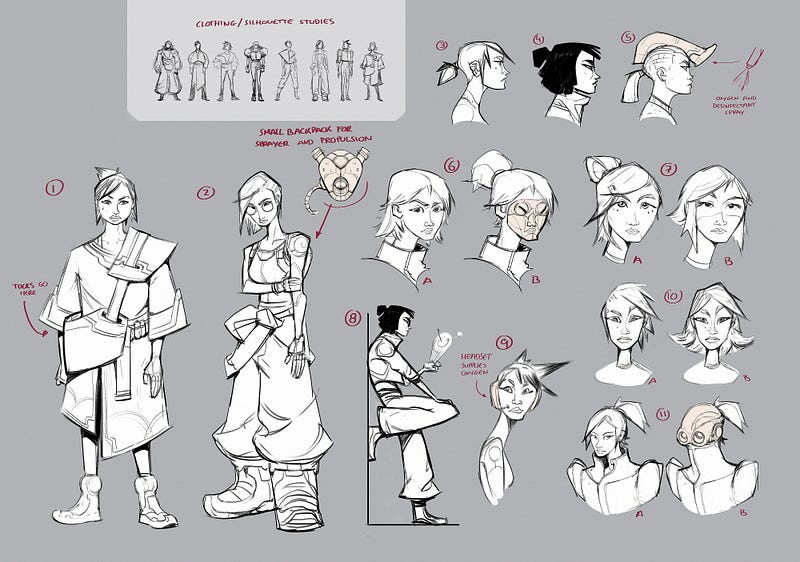
Early concept art for the design ofDalia.
Then she gets the call that changes everything. A message from Hale, saying a crisis has engulfed the Cluster and a Scarab is neededan unknown catastrophe, with an unknown death toll. Dalia returns, alone, and despite her experience and tools of the trade, she is unprepared for a homecoming like this. Dalias return is anything but heartwarming. Dalia must come to terms with her choices, as well as her survivors guilt, as she investigates the crisis that killed almost everybody she knew. Dalia will uncover a universe that is larger and weirder than she ever couldve imagined.

Developing Dalia
Dalias perspective is integral to the story of Ambrosia Sky. She isnt just here to do a job; shes here to reconcile her own guilt, confront the mistakes shes made, and learn how to forgive herself.
For me, Dalia was always our main character of Ambrosia Sky. I knew right from the start that the story of this world would shine if paired with an emotionally complex protagonist, providing an additional layer to the stories of grief and death that players will encounter. Dalia needed to be smart; shes a scientist, but shes also not easily grossed out, two strengths that play nicely in contrast to her somewhat emotional immaturity. When things get tough emotionally, Dalia tends to run away. Except this time she cant. She has to see this through, at first because its a job shes trained to do, but then because shes invested in trying to save Maeve, and by extension, learning to look at her emotions directly.

But theres more to Dalia than just her job. The early process of developing Dalias character included stacking the story and game objectives for her with references. The biologist from Annihilation was a huge early inspiration for Dalia, somebody who charges directly into unknown waters with a curiosity that can be dangerous to her. Despite her uneven emotions, Dalia doesnt reveal them. She keeps her secrets close to her chest, and her feelings even closer.
The voice acting for Dalia really encompasses this range, this clinical detachment mired by extreme emotional tumultuousness. Writing Dalia was really about tapping into the ways in which we are dishonest with ourselves, and a lot of what I brought to Dalia from myself was my ability to overintellectualize my emotions instead of just feeling them. Dalia is a person who spends a lot of time in her head and, as such, struggles to accept the larger emotions that still manage to dominate her, despite her ability to rationalize them (if she even thinks about them at all).

One of the earliest sketches ofDalia.
Even from our earliest days, Dalia has always been Dalia. Theres parts of her that have shifted and morphed through development, particularly as the plot got solidified, as other characters came into focus, and as the story needs evolved as our game evolved. The core of her has always been there: this clever, emotionally detached woman trying to reconcile her own needs with those of her family and the people she loves.
As such, I hope players find comfort in Dalia. Shes made mistakes. Shes hurt people. But shes trying to find a way through those emotions to help the people that she can, and to learn how to forgive herself. What Ive brought to Dalia, and what I hope others can take from her, is navigating how to be gentle with ourselves while still doing the difficult, necessary work of accepting who we are, flaws and all, in order to show up for ourselves and others.

If you want to know more about the development of Ambrosia Sky, take a look at our prior dev logs that cover the role of a Scarab , the art & audio direction of the game, a look at the tech & design behind our cleaning mechanics, and an overview of what Ambrosia Sky is.
You can also download the https://store.steampowered.com/app/3716830/Ambrosia_Sky_Demo/"" style="color:#bb86fc;text-decoration:none;">demo from Steam to step right into Dalia's shoes and see the crisis firsthand. In our next devlog, well begin to talk about the cast of characters that surround and support Dalia on this journey.

In this weeks devlog, we speak to Greg Harrison and Michelle Hwu, the composer and audio director for Ambrosia Sky, respectively. They share insights into using sound & music as worldbuilding, discuss the instruments and methods used in composing tracks for the game, and reveal the first full track for the game (demo players will recognize it!): Geralds Last Rites .

Can you describe how you approached the music for the Clusters different generations?
Michelle: When I first learned where and when our game takes place, I got really curious about how music and art might have been created and preserved in our futuristic, sci-fi world. Kait outlined the three generations of humans that lived on the Cluster, which helped shape my understanding of how music might have evolved over roughly 200 years. People leaving Earth for Saturn would have brought only specific items and materials, which would impact what could be preserved over time. I wanted my early exploration of the music lore to serve as a foundation for our games soundtrack.
From there, I came up with some loose guidelines for each generation and how that would influence the games sound. For example, I imagined that when people first arrived on the Cluster, wood was scarce, large instruments were hard to come by, and they had to make do with whatever they could find, such as metal scraps from ships, mycelium, and beast bones. That got me thinking about how we could incorporate a sense of primitive technology and accessible instruments into the games music, using items like bones, jaw harps, ocarinas, and conches. I was introduced to Grejs music, which felt like a perfect match for our worldhes well-known for blending organic and electronic sounds in a really compelling way, and I knew he would be able to bring a great sound to our game.

What different types of instruments and sounds did you play with?
Grej: The Cluster was an invitation to think outside the box and explore what kinds of sounds might have existed and evolved over time in a completely different world. I considered what resources would be available, which instruments might have survived the journey from Earth (and which didnt), and how those instruments might adapt to new contexts. What if bellows were used as percussive tools instead of for breathing air into a reed instrument? What if bowing a cymbal could transform it into something melodic? What if flutes were resonated by springs? These kinds of questions became the blueprint for the score. My intention was to make the Cluster feel aliveand to do that, I knew I had to build things from scratch.
I began by exploring found sounds: scrap metal, bones, springs, pipes and tubes, cymbals, and various synthetic skins. From there, the experimentation really blossomed as I searched for expressive ways to bring these textures to life. One of the main thematic drones youll hear is created by playing a jaw harp through a tube and processing it through layers of granular reverb, resulting in an organic, growling sound that feels unique to this world.
Can you describe your process for composing the music that plays during Geralds death ritual?
Grej: I really appreciated the teams approach to death in the game. While much of the score leans into dark, ominous textures, Geralds death ritual felt like a space to shift into something gentler, something beautiful.
In contrast to all the bespoke, clustery instruments I built for the world of The Cluster, I wanted to introduce a sound that felt pure and transcendent. For me, the piano embodies that feeling. Its an instrument that doesnt exist on the Clusteralmost a mythical relic, a distant memory from Earth. Using it in Geralds and Kais rites became a way to musically connect them to their ancestors as they cross into the beyond.
The piece itself unfolds like an intimate dirgenot heavy or mournful, but quiet, reflective, and reverent. Its also one of the only moments in the game where vocals appear, adding a human fragility to the farewell.
How does the music interact with the level design and gameplay experience? How do you account for player action?
Michelle: Grej and I wanted each track to evolve in its own way as the player moves through different levels in the game. We have several distinct mission types, and each one calls for a different musical vibe. Some needed to feel more exploratory, while others had to align closely with the narrative. Then there are moments where the level ramps up into full-on, fast-paced action. While working with Grej, we ensured that each section of music had sufficient variation based on the players choicesspecifically, the path they take, the duration of their stay in an area, and their subsequent actions. We were constantly thinking about the mood of each level and what we wanted the player to feel at every stage.
Sometimes, the music needed to take center stagelike during the death riteswhile other times, its more of a background groove for tasks like cleaning fungus off a level or just casually exploring for items. The fact that our main character often wanders through abandoned spaces filled with dead bodies significantly shaped the darker undertones that appear in our soundtrack.
What inspirations did you draw from for the music and sounds of the game?
Grej: Michelle gave me a lot of great influences to start with. One of the main themes we focused on was incorporating throat singing and jaw harpssounds with deep, organic qualities. My goal was to take those traditional elements and push them into really unconventional, unexpected contexts to fit the world of the Cluster.
Since Michelle and I both have backgrounds in classical and contemporary percussion, we wanted to blend scrap percussion with driving electronic layers. Finding a balance between the raw, natural qualities and the more synthetic, rhythmic elements was key. We aimed to create music that felt fresh, immersive, and approachable, allowing players to emotionally connect with the soundscape while experiencing something new and unique.
Michelle: Some of my early inspirations came from experimental artists who lean heavily on percussion, like Yosi Horikawa and Steve Reich , along with cinematic soundtracks like Mica Levis Under the Skin , Colin Stetsons Hereditary , and Clint Mansells Moon . A big focus for the games soundscape was capturing the feeling of being alone in space, while still hinting at the vibrant history that once existed there. The phrase weird and wonderful became a guiding idea throughout the process, particularly when illustrating how the fungus took over the Cluster and reshaped the landscape.
We wanted to create a fresh, unique take on how a sci-fi game can sound, especially since were not making a typical space marine-style title. Ive always loved using found soundstaking whatever materials are around and turning them into organic soundscapes, which is what led me to work with Grej. He explored new ways to play familiar instruments and gave them a fresh twist.
Do you have a favourite instrument you like to work with, and if it made its way into the game, how?
Grej: I used a lot of granular synths like the GR-1, Lemondrop, and Omnisphere to turn all these found sounds into playable instruments. One sound I was really excited about was called the Beast Teetha mix of actual teeth and jawbones (dont ask) combined with a pitched-down vibraslap. Playing this on a keyboard instrument was incredibly fun!
Michelle: There are a number of standout sounds that Grej designed, but one of my personal favourites is when we hear the DynaCrasher, which appears in some of the later levels. It has a sharp, percussive quality (which we jokingly call the tsk tsk) that cuts through the mix with precision, helping to anchor the rhythm during high-intensity sequences. He also created a great sound which we lovingly referred to as the FZEW FZEW, which is a combination of analog synth layers with processed metal samples to produce a static-laced, almost electrical texture that gives the soundscape a sense of tension and movement.
From a team perspective, we were especially excited by the positive reactions to Grejs use of throat singing sounds. We integrated them across several tracks, using layered harmonic overtones and low-frequency textures to evoke a sense of ritual, which added depth to the games darker, more atmospheric moments.
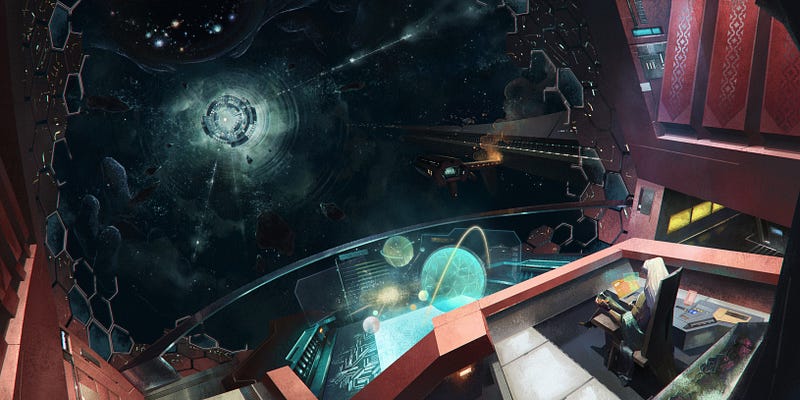
How do you score a piece of interactive media compared to something more traditional, like film?
Grej: This was my first video game Ive worked on, and I was super intrigued by how an interactive medium can really influence the compositional process.
I began to notice parallels with contemporary music styles, particularly in the works of John Cage. Cages use of chance in many of his later compositions inspired me to approach the score as a living, evolving system rather than a fixed piece. This way, the music could feel alive and responsive, reacting dynamically to the players choices and progress throughout the game.
Michelle: One of the most interesting parts of collaborating with Grej was learning to communicate in different wayssometimes through more traditional, linear scoring approaches, and then translating that into something that works for interactive media. His fresh approach to composition initially pushed the limits of my Wwise implementation skills, but once we figured it out, it was incredibly rewarding. We ultimately found some unconventional ways to manipulate Wwise to achieve the desired results, which is always a fun challenge. The outcome is a set of music transitions that feel much more organic and seamless as players move through the levels.

Gregory Harrison, also known as Grej is a dynamic and multi-faceted musician, composer and producer based in Toronto. Gregs an East Coast Music Award winner and Dora-nominated composer, with over 50 composition and recording credits spanning concert music, film, and interactive media. His commissioned works include projects for Toronto Dance Theatre, ProArt Danza, Popular Demand Pictures, and Architek Percussion. He has toured internationally with artists such as Jeremy Dutcher, Cirque du Soleil, and The Cybertronic Spree, performing at venues including Massey Hall, NPRs Tiny Desk, the JUNOs, and The Kennedy Center. Gregs work explores the intersection of acoustic performance and live electronics through his innovative use of music technology.
Michelle Hwu is the Audio Director at Soft Rains, with over a decade of experience in both games and post-production for film and TV. Her work in games includes audio roles at Ubisoft Toronto, Beans, and Drag Her!. Originally trained in Percussion Performance at the University of Toronto, Michelle has performed with ensembles such as the Toronto Symphony Orchestra, the YouTube Symphony Orchestra, and the Esprit Orchestra. In post-production, her credits include projects featured at TIFF, Sundance, and the Tribeca Film Festival, along with work for CBC, NBC, and Shudder. Most recently, Michelle was recently nominated for a Canadian Screen Award in Sound Editing for the film In A Violent Nature.

To stay up to date on Ambrosia Sky and to support our team, please wishlist the game on Steam , join our community Discord , and follow us on social media .
by Gabriel Packer

Adam Volker has worked in games and animation for 13 years. He worked briefly in AAA games at BioWare and Midway as a concept artist. Then, art directed the short film The Fantastic Flying Books of Mr Morris Lessmore, which won an Academy Award in 2012. He was nominated for an Emmy in 2018 for Manifest 99, a narrative VR experience. Now he works at Soft Rains creating narrative and mechanically peculiar games while trying to make them as pretty as possible.

Ambrosia Sky is set on colonies built on the back of asteroids nestled in the rings of Saturn. Its about Dalia, a Scarab . Familiar with death, a scientist enlisted to cure humanitys mortality on her return journey home. Our Narrative Director, Kait Tremblay, had built this incredible world in their head. I felt like my job was to distill the parts that needed to shine for the player and make them real.
When players pick up the controller to play what youve made, you have an opportunity to spark their imagination, to show them a world they havent thought of, and if youre lucky, inspire them to make something and pay it forward. Good art is cumulative.

I strive to create a distinctive style for each project. There are centuries of brilliant 2D art to be found. So many styles to explore that artists before me have expressed in paint (digital or otherwise). What havent I tried to translate into 3D yet? Just as importantly, whats cool looking? What sounds fun to try!? I pick one or two strong references for myself and the 2D team to dissect, understand, and internalize. Then we method act our paintings, using the tools taught to us by other painters and render objects from our unique world with those rules. The painting below is me trying to paint the large graphic shapes from our references with details inside, and design a building unique to our colony.
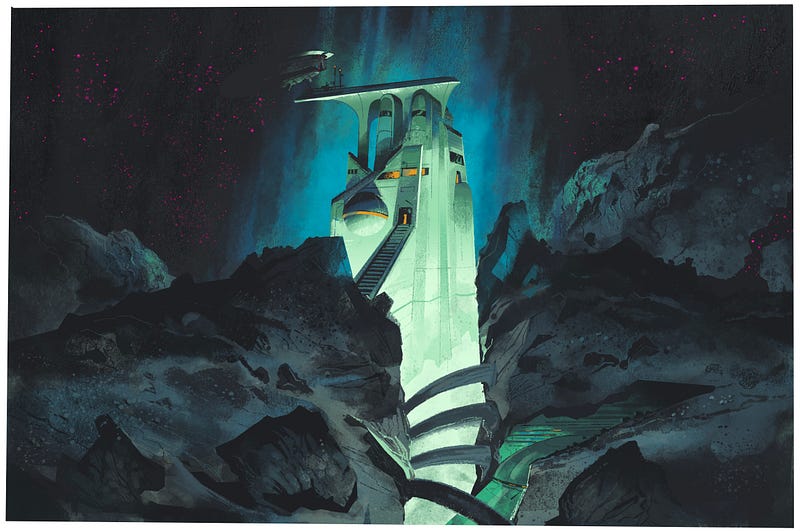
You can try, but you cant erase your own way of painting; its a beautiful thing about creating anything. Everyone has a style, whether they paint or not. Even as our concept team tries to emulate the style of the specific references Ive chosen, we trust the process to produce something wholly unique. Its a fun exercise to start each project by combining simple, strong references and my own precious biases. (haha)
To get us started and to help direct the team towards what Im aiming for, I made this spectrum and placed our goal on it. The two axes, one for the design of objects and the other for the final rendering style, helped us define what we wanted the word stylized to mean.

Its a pet peeve of mine the way our industry uses the word stylized to describe non-realistic visuals. For our Ambrosia Sky, we wrote our own definition. There is so much media out there that is really good, and if you have the appetite, even more after that. Its 2025 now. We drink from a visual firehose. It means the chance to surprise people when you actually get their attention is special. We only get so many at bat.
I was looking for painterly detail, rendered inside graphic forms. A stylized world where colour choices werent literal, and subverted expectations of what outer space might look like. I feel like every year, our photographs of space bring back new colours, new textures that were there and we didnt see before. Its still such a big mystery whats out there. We had to try to represent visually more than we know now. For instance, we designed our airlock door to spin as a sphere instead of opening on a hinge. Why not?!
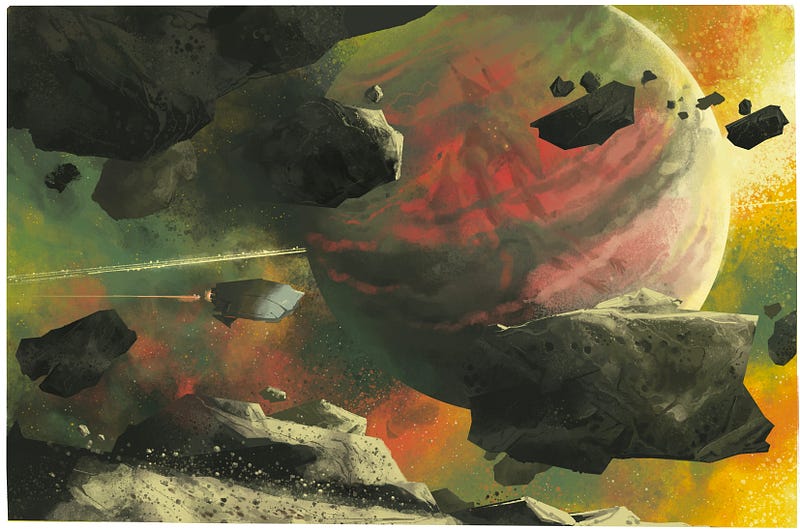
Our game features vast, desolate spaces filled with fungus. Part of our game involved giant, dead space creatures so that we could dip our toes into the realm of fantasy. But at the end of the day, to hold the gravity of our story that is about death and lifes finality, the game needed to be credible. The world needed to make sense and had to have a rich amount of detail. Even if it was stylized. Shared language is crucial when trying to establish a unique style for a game. Despite our sophistication in design, not everyone thinks of the same references in the same way.
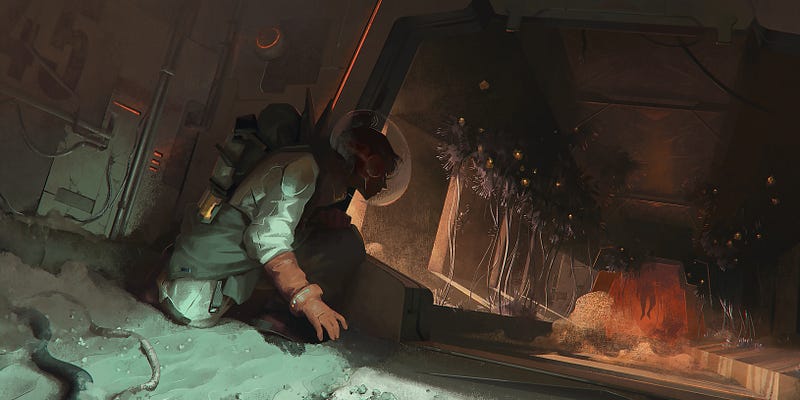
The visual language of any project should be built alongside the story of the world, reinforce the gameplay and highlight the themes of the idea. Production design involves translating a theme into a visual language, being specific about details, and adhering to a concept throughout the entire production. Its a question and answer. What designs support Dalias journey? How do we make a maximalist game about fungus legible?
Ysabel painted this; she is one of the most talented painters Ive worked with. She put mood, design, organized colour, stylized brushstrokes AND story all into this image. This was a milestone painting for articulating the game. When she painted this, we hadnt started building out our 3D kit for the game yet. This piece was a north star then, and still is one I return to, reminding me how the game should feel.
Concept art is for iterating, its for exploring. A good piece of art inspires the teams imagination to create the game depicted in the picture, but concept art is a promise. After a few months of painting the building blocks, it was time to translate it into engine. We had some influences, a clear distinction of what we were after, and a huge stockpile of lore, character writing, and themes to draw from. Now we had to climb the mountain.
We filled in the corners of the world with paintings. Built a design language for the technology, and layered in history for different ages of architecture. Another huge challenge of the project was the life form Dalia encounters when she finally lands on the Cluster. The exo fungus.
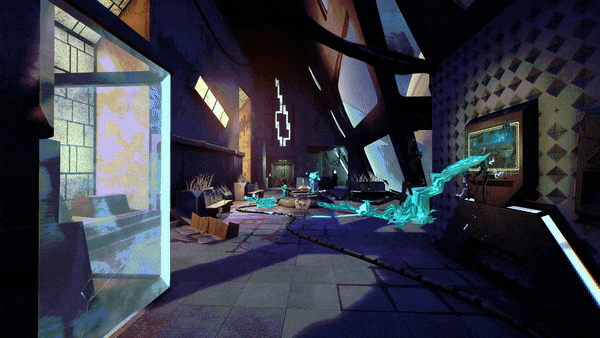
Malicious space fungus that has overgrown the living spaces, airlocks, and facilities of her hometown. This was not only a set piece of our gross, dead, derelict world, but also the core of the gameplay. To uncover the truth about what happened to her friends and loved ones, Dalia must face a mutating, growing enemy by cleaning it away.
Each fungus has its own gameplay parameters, behaviour and interaction with the world. As Dalia learns what it does, we as players do too. It needed to be awful and beautiful. Gross and alluring.

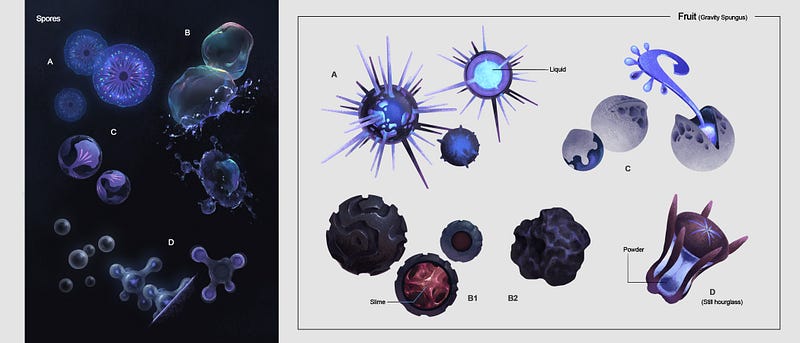

We settled on high visual density, but not high detail. Graphic shapes everywhere, simple colours. Players needed to walk into a busy room, find what they were looking for immediately, assess the danger level in a room quickly and plan their route around it. With everything glowing, growing, and fighting for your attention, we chose to make each funguss shape design unique, individualize the colours between them, and keep the silhouettes strong so players wouldnt be overwhelmed by what they saw.
The final challenge was turning the art wed painted into an explorable 3D space. The design of the forms was straightforward. Build something big and flat to grow fungus on top of, easy. Making it feel painterly was harder. It took us several iterations and a lot of open-minded experimentation, but we got there. I think the game looks beautiful.

Please wishlist the game on Steam , join our community Discord , follow us on social media , and, of course, download the https://store.steampowered.com/app/3716830/Ambrosia_Sky_Demo/"" style="color:#bb86fc;text-decoration:none;">demo to get your first hands-on experience with Ambrosia Sky.

At Soft Rains, world-building is at the heart of our creative process. This isnt just about how we write; it unifies everything we do, from art direction to audio to game design. And if worldbuilding is the centre of our process, the player character is at the centre of our worldbuilding. Dalia, the protagonist of Ambrosia Sky, is a scientist first and foremost, so weve designed the ways she interacts with the environment to represent this. Beyond that, Dalia knows this place: she was born here, long before the crisis that prompts the actions of the game.
The core of Ambrosia Skys gameplay revolves around cleaning up after the alien contamination that has decimated the Cluster (the agricultural colony in the rings of Saturn in which our game takes place), resulting in mass death and a lethally overgrown environment. The cleaning gameplay isnt the only central game system in Ambrosia Sky. Still, it is one of our biggest, so we wanted to spend some time talking about the different ideas that comprise our main gameplay verb: cleaning with a chemical spray and the alien contamination that you are tasked with cleaning up.
Weve already seen people describe Ambrosia Skys core gameplay as a combination of PowerWash Simulators cleaning and Metroid Primes atmospheric exploration. Youre here to find the victims of the crisis and clean up the deadly fungus that killed them. But the alien fungus of Ambrosia Sky doesnt want to be cleaned. It can hurt the player by shocking or burning them. It can also move, chase, and impede you through the environment. To help our fungus blur that line between enemy and environment, weve invented a voxel-like system where cleaning can be tactile, allowing you to carve a path through masses of fungus, but well get to that in a minute.
First, lets meet the alien contamination that has overrun the Cluster.
Meet the Alien Contamination
The alien fungus is the naturally occurring flora of our setting, The Cluster. Humans discovered it here roughly 90 years before the events of Ambrosia Sky. In classic human fashion, we colonized the Cluster, exploiting the local ecosystem, and thought of ourselves as its masters.
But this ecosystem is unstable. Players will also experience this instability in-game (the first mission, as seen in our https://store.steampowered.com/app/3716830/Ambrosia_Sky_Demo/"" style="color:#bb86fc;text-decoration:none;">demo, is a great example!). As players collect organic samples for study, the act of extraction will cause a cascading response from the environment itself, triggering fungal growths that are, quite frankly, a bit furious at you for disturbing their ecosystem.
Our alien fungus is both environment and enemy, but its also a deeply embedded part of our resource system and upgrade paths, as well. Internally, weve used the phrase farm-to-table fungus, referring to a type of fungus that exhibits specific behavioural patterns in the environment and can also be harvested to create specialized sprays (among other upgrades) based on those environmental behaviours.
To support this, our fungus colonies are composed of two sections: the main roots/stalk of the fungi, which comprise the majority of a colony, and the fruit. For the amateur mycologists among you, we use the term fruit here in the same way scientists distinguish a mushroom fruit from hyphae (or roots) of a mycorrhizal network.
For example, with our electric fungus, energized roots sprawl across walls and deal damage to unwary players. Along these roots, players will occasionally see stalks ending in crystalline fruit, which emit a dangerous area-of-effect.
Using either the sprayer or the tether, players can disconnect the fruit from the roots, neutralizing the threat it presents. This allows the fruit to be harvested and then used to upgrade your chemical sprayer. The most exciting upgrade enables Dalia to create an electric spray that can be used to create electric conduits and surfaces to conduct electricity to unpowered doors and similar devices.
An exploder fungus, on the other hand, well, explodes.
Acting like an abominable cross between a puffball mushroom and a proximity mine, exploder fungi expand the closer you get, eventually bursting into flame to protect itself. Harvesting exploder fungus fruit is a bit more volatile (thanks to its explosive nature), but becomes easier in zero-g, when the fruit floats more delicately in the air, rather than tumbling down and exploding upon impact. Like with the electric, players harvest exploder fruit by severing the fruit from its base, but with exploder, this is done by carving through the thick roots. You can harvest exploder funguss fruit to craft flammable sprays, which can kill fungus or spread fire to nearby flammable objects. Or you can set off a chain reaction of explosive fruit, letting the resulting fire burn away the large fungus colony that remains.
Jules Glegg (Technology Director) explains that,
there are the simulation elements. We created a custom simulation system just for Ambrosia Sky, geared specifically to introduce the kind of hazards that matter in spacelike fireand to let Dalia use her creativity and know-how to manipulate those hazards in her favor. Ambrosia Skys simulation lets fungus interact very directly with the environment, for example by overloading an electric circuit that controls the exit door. It also gives clever players more ways to clean, like toppling a massive spire of electric fungus just by knocking its base out from under it.
This design approach gives us a lot of flexibility, allowing us to fill spaces with the alien fungus in interesting ways, creating traps and hazards that players have to contend with, and creating an interesting risk/reward of whether to carefully prune the fungus to harvest the fruit, or to clean the whole thing up to make progression easier. Below is a concept exploring the different layouts an exploder fungus could take to operate as an environmental threat.
Jules goes on to say,
Fungus is so fun to work on. Its all familiar game development problems, in a totally wild new combination that throws out a lot of the standard solutions. First, theres the problem of how to let a level designer build a colony, shape it to their liking, and trigger when it should grow. For this we use Houdini (a workhorse application for visual effects artists) and a cool example of nature-inspired math called the Space Colonization Algorithm . The resulting tool lets a level designer drop fungus into a level, set up areas for it to avoid, mark spots where theyd like a fruit to spawn, and then grow the colony right towards your face as you round a dark corner.
Making Cleaning Satisfying
In addition to making the fungus feel alive, compelling, and threatening, we also wanted to make cleaning it up feel incredibly satisfying. To clean up the fungus, Dalia is equipped with a chemical sprayer. Its her primary tool, and its base spray dissolves organic material on contact.
Designing Dalias sprayer, both the look and the feel of it, was a lot of fun. We went through a variety of designs, some of which felt more like a pistol, and others that, quite frankly, felt more like my Dyson vacuum cleaner. With these explorations, we ended up somewhere pleasantly in the middle: a tool that feels powerful and effective, but is obviously designed for cleaning and restoration rather than combat (although it is helpful in combat, especially when your enemies are furiously sentient alien fungus).
The interaction between the sprayer and the fungus is key to making cleaning feel so good. The electric fungus is super brittle and shatters pleasantly on impact. But we wanted our exploder fungus, a much chunkier fungus, to feel different when it is being cleaned. We wanted the ability to carve out chunks of it, to be able to burrow through it even. So cue: Quantized Impact Field, our unique destruction tech. To explain Quantized Impact Field, or QIF, heres Jules:
Quantized Impact Field! QIF (pronounced kiff) is the tech that lets you clean fungus in precise chunks or even tunnel through large colonies. Lots of games have this kind of volumetric destruction, but we really wanted to find a way of doing it that avoids the usual tell-tale blockiness and supports Ambrosia Skys very hand-made, stylized art direction.


Jules goes on:
To give a little more detailas you clean, QIF records every sprayer hit into a grid of cubes called voxels. That data is then used to change the physical collision of the fungus, so you can walk through the cool tunnel you just made, and also sent over to your graphics card where we use it to change the appearance of the fungusmelting it, crumbling it away, whatever the artists want it to do.
In our next Ambrosia Sky developer log, well take a look at the art direction and the decisions that went into giving Ambrosia Sky its distinct visual identity.
Jules Glegg is Soft Rains Technology Director, where she spends most of her time guiding the development of gameplay systems and wrenching on simulation code. Previously, Jules worked on League of Legends, Legends of Runeterra and VALORANT as a Principal Engineer at Riot Games. She is a co-founder of Trans Game Dev.
Please wishlist the game on Steam , join our community Discord , follow us on social media , and, of course, download the demo to get your first hands-on experience with Ambrosia Sky.
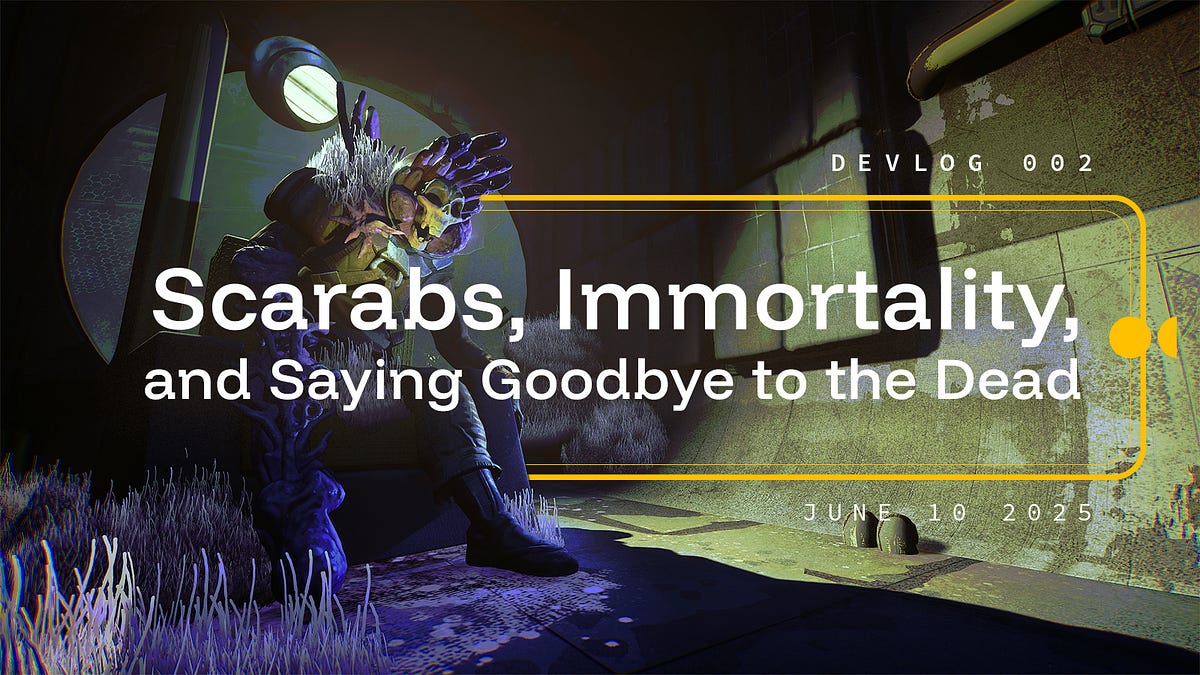
Welcome to the second of our developer logs on Ambrosia Sky! In this initial series of dev logs, well dive deeper into certain aspects of Ambrosia Sky, Soft Rains first-person clean em up game about exploring an agricultural colony in the rings of Saturn that has been devastated by an alien fungal crisis.
In Ambrosia Sky, you play as Dalia, a disaster clean-up specialist known as a Scarab. Scarabs are a loose outfit of self-trained scientists, whose specialties are a blend of biology, engineering, and religious mysticism. This blend of focus and specialties informs Dalias perspective and how she interacts with the world around her. Scarabs get sent to sample the DNA of people who have recently died in strange or biohazardous scenarios. Their job is to both lay the dead to rest and clean up the potentially contaminated environment in which they died.
Early concept art from art director Adam Volker exploring the moment of Dalia beginning a DeathRite.
As sci-fi analogues to real-world bio cleaners- people who are sent into places to clean up after people have died - Scarabs prioritize care in their job. They are not sent here to save anybody, nor are they soldiers; they are mortuary scientists whose job is to catalogue and to clean, to restore a space to working order and to respectfully say goodbye to the dead. Inspired in part by my previous writing work on A Morticians Tale, as well as other media like Annihilation (both the book and the movie, for different reasons), and real-world experiences, Scarabs represent a hidden job that focuses on care and community, but is extrapolated into a sci-fi setting.
But what exactly is a Scarab? Scarabs are mystical field scientists whose job revolves around the dead. Founded when humanity first ventured into the galaxy, Scarabs seek out death in the universe to understand the effects the cosmos has on human bodies. What kills us? Why? And can we harness this knowledge to stop cellular decay? The answer to these questions informs the basis of The Ambrosia Project.

The AmbrosiaProject
Screenshot of Dalia coming upon Gerald Parker, an older man she remembers from her youth, who has consented to be part of the AmbrosiaProject.
A common maxim unites Scarabs: understanding death in space is the key to protecting human life amongst the stars. This is known as the Ambrosia Project, a collective effort to research a panacea that can prevent cellular death and decay in humans. In effect: immortality. It is a Scarabs most important creed.
Throughout the project, particularly in its early stages, we conducted extensive research to establish our world. Due to the Clusters agricultural setting, we conducted extensive research into NASAs existing efforts to grow and cultivate crops in space. But I also jumped into the deep end of immortality research, or, more mundanely, anti-aging research. What was the existing thought on life extension, from a cellular level? We didnt want the Scarabs to be pursuing the elixir of life or some magical substance that can be consumed; we wanted them to think concretely about cellular decay and how life in the galaxy affects and could interfere with our cellular growth and death. This led us to consider telomere extension, examining NASAs Twin Study to investigate the impact of outer space on our DNA and bodies, as well as delving into gene editing. It was fun! It was weird. The research made me start lifting heavier weights and eating more cauliflower.
To progress the Ambrosia Project, Scarabs are sent to investigate deaths in the universe. Because Scarabs research requires taking large swaths of cellular samples from recently deceased individuals that occur in a variety of environments (to study protein interactions), Scarabs, by necessity, have to be nomadic. They go to lots of strange places, see how people died, and see what their deaths can teach us about our cells.
So when they are on a job, Scarabs priority is to take a sample of the deceaseds DNA to upload to the Ambrosia Project. After that is done, Scarabs perform a bioremediation, an organic act of cremating the remains via specialized spores. (A lot of Ambrosia Sky is also inspired by our teams real-life experience foraging for fungus.) Importantly, Scarabs only perform death rituals on the deceased who have consented to having their DNA included in the Ambrosia Project, and who have passed within a 48-hour window.
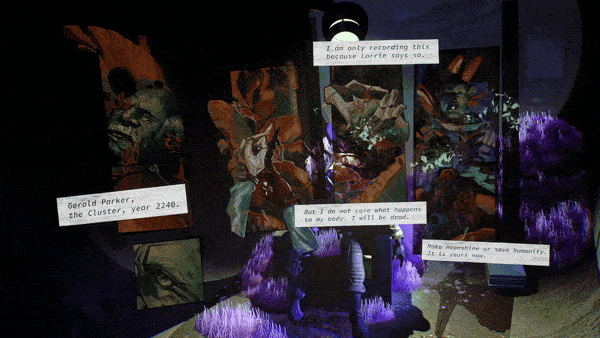
In-game bioremediation VFX
When we first started thinking about the Scarabs, creative director Joel Burgess and I quickly realized that the Scarabs needed a motivation beyond their specific job, something that would compel individuals to leave their home colonies behind and to seek out dangerous places where people have died. We wanted to add a unique flavour to the Scarabs, making them feel haunted or feared by others. Adding a grandiose goal of seeking human immortality provided the additional element we were looking for. They became strange in addition to being scientific. In an early prototype, I wrote a line that described the Scarabs as star witches, a sort of cute in-world way to poke fun at the blend of science and spiritualism we wanted the Scarabs to embody. Star witches became an instant pillar, providing us with a coherent summary of what makes Scarabs who they are.

Medieval Medicine and Cosmic Folklore
Early explorations of what Scarab gear could look like, done by CarlosRuiz.
Ive always been somewhat obsessed with the concept of plague doctors and medieval medicine, and, importantly, how folklore influences medieval science. A big, compelling theme for us, as we think about sci-fi fantasy as a genre blend for Ambrosia Sky, revolves around the idea of what makes folklore so interesting, in the way that its people trying to make sense of something with the best information they have on hand. And we started thinking about what it would be like when we first truly start exploring and settling in the cosmos: what do we know, but more importantly, what dont we yet know? And how would we experience those things that we dont know, and what theories and stories would we devise about them to help us understand them?
This is where the plague doctor analogy came into play for me. Scarabs are scientific, but theres a lot they wouldnt know about how human bodies respond to prolonged life in the stars. So, theyre informed by real, proven scientific methods, but that gets blended with a folkloric approach to understanding the things they cant yet grasp. It makes them a bit magical, a bit medieval in their thinking, grounded in what we know of science and death today.
Fortunately for us at Soft Rains, we have Fiona Jeeva, our associate technical artist, who is also a biochemist. Sure, I could read as many anti-aging books as I liked, but I was still finding the line between coherent and compelling, and Fiona was absolutely instrumental in not letting me get too far off the rails with this folklore-meets-scientific approach to the Scarabs.
Fiona then assigned me homework and articles to read, which I appreciated.
Concept of the flower that remains behind after the bioremediation is complete, an exploration of blending the scientific with the mystical of the Scarabs (credit: AdamVolker).
Working with Fiona on the Scarabs helped ground the grandiosity of the Scarabs into a scientific method. Particularly, we discussed extensively how the Scarabs sample the DNA of the corpses, what they are looking for, and how it would all work. Fionas why we discussed the role of environments in protein interactions. Fiona heard me say the word telomeres and asked me why I was interested in them. It was thanks to these conversations with Fiona that we developed the 48-hour rule for sampling human bodies: people who consent to the Ambrosia Project have to have their samples collected within 48 hours of their death, or the samples become non-viable.

Last Wills and Giving Voice to the Dead
Early sketch of Dalias emotional state after a Death Rite is completed by AdamVolker.
In Ambrosia Sky, the quest for immortality, known as the Ambrosia Project, manifests in the moments of laying the dead to rest, which we refer to as Death Rites. While scientific in approach (obtain the DNA sample needed to advance the Ambrosia Project), Death Rites are also highly intimate moments with the deceased. While performing a Death Rite, Dalia will listen to the deceaseds Last Will, a testimony that is recorded as proof of their consent to be included in the Ambrosia Project.
These Last Wills give voice to the dead, offering a range of perspectives on our own mortality as told through the eyes of somebody willing to donate their body to scientific research. Some are able to look at their own impending death straight on, others require humour and distance to accept their mortality, and others need to believe in something greater than themselves to be able to accept it. We really wanted these Last Wills to convey the different ways we all feel about and think about our own mortality. This is where a lot of the work I did writing for A Morticians Tale is really felt in Ambrosia Sky: both games strive to convey with compassion the different ways people respond to death, but with Ambrosia Sky, we wanted to have the opportunity to explore how we feel about our own death, rather than the death of our loved ones.
Each Death Rite is different, and each one affects Dalia in a different way, as some are people shes known her whole life, and others are complete strangers.
Like the rest of Ambrosia Sky, even the identity of the Scarabs is a wonderful mixture of our teams collective inspirations, experiences, and influences. And as Dalias job, Scarabs inform a lot about Ambrosia Sky, from the writing to the story to the gameplay. In a future dev log, well dive deeper into the gameplay of Ambrosia Sky, exploring the details of how the Scarab job manifests in gameplay specifically.

Please wishlist the game on Steam , join our community Discord , follow us on social media , and, of course, download the demo to get your first hands-on experience with Ambrosia Sky.
Over here at [u]Soft Rains [/u], weve just announced our first game that weve been working hard on: [u]Ambrosia Sky [/u]! If you missed our announce trailer in the PC Gaming Show, you can check it out [u]here [/u].

Were kicking off a series of developer logs thatll dig into different aspects of the game and some of the creative choices we made along the way. But before we sink our teeth into that, lets take a moment to ask: what exactly IS Ambrosia Sky?

The Game: Clean em up as care
In Ambrosia Sky, you are Dalia, a deep-space disaster specialist dispatched to the rings of Saturn. As Dalia, youll lay victims to rest, clean up alien fungus, and research its strange origins. But this isnt just another random job for Dalia: the place she is dispatched to, the Cluster, is her home. This is the story of Dalias homecoming, a woman who left this place behind when she was a teen and now has to return under tragic circumstances.
Ambrosia Skys core gameplay is a blend of meditative cleaning and FPS-style action, grounding these two proven foundations in an immersive world. To talk about it in classic this-with-that terms: its a bit like Metroid Prime meets PowerWash Simulator.

When we first started thinking about Ambrosia Sky, we were initially interested in how we could blend the job sim style of gameplay, similar to PowerWash Simulator, with narrative-heavy exploration. This led us to consider different forms of cleaning in the world, which in turn led us to death cleaners and individuals who clean up after a person passes away. We then connected those acts of care with the rigorous standards of jobs in biohazard cleaning.
It instantly clicked, and we explored those ideas through immediate prototyping of the cleaning mechanic. Even in its earliest, wild-idea, brainstorm moments, Ambrosia Sky was a reflection of our collective taste, experiences, and inspirations. As the game evolved through prototypes and playtests, and as the team grew, the raw material of the idea constantly germinated into something more interesting and unusual than any one of us would have crafted on our own. And once we got in-engine, the idea worked.
The core of Ambrosia Sky, of course, is the cleaning gameplay. As Dalia, you use a chemical sprayer to clean up the alien contamination that has caused the disastrous crisis, killing almost everybody that Dalia once knew. But the alien fungus isnt a sedentary presence, just there to be cleaned. Each species of alien fungus blurs the line between environment and enemy with unique behaviours, causing fiery explosions, interfering with electricity, or actively seeking out Dalia.
Each fungus also has its own fruit, which can be harvested and researched. That research enables Dalia to create new spray types that, in turn, replicate the gameplay effects of the fungi from which they are derived.

But Dalia isnt just here to clean up the contamination. Shes also here to find the recently deceased. As you explore, youll encounter victims of the crisis and lay them to rest. These scenes reveal the mystery of the crisis and connect the disaster to the lives of the people who fell victim to it. These Death Rites offer an opportunity to learn more about the people and this world, as well as catch a glimpse into the varied relationships we all have with death and mortality.
All of these actions make up the role of a Scarab, Dalias day job. In our next developer log, well dive deeper into who Scarabs are, what they want, and how this perspective shapes Dalias story and her as a playable character.

The Setting: Saturns Cluster
Our setting, the Cluster, is an agricultural colony established in Saturns rings during humanitys early exploration of the universe. A source of naturally growing alien fungus, the Cluster was hailed as a hallmark of humanitys ingenuity: an agricultural station that could sustainably supply food for human life off-Earth.
But that frontier era was over 90 years ago. These days, generations have passed, and they have formed their own unique cultures and identities. Now, the Cluster has slipped into obscurity, a crucial yet bygone fixture in humanitys extraterrestrial infrastructure. Gone are the glory days of the first generation, and Dalias generation must now contend with their home as a mostly forgotten waystation en route to all the galaxy has to offer, a relic clinging to its prestigious history.

Early on, when we first started thinking about creating Ambrosia Sky, we gave a lot of thought to the type of science fiction that truly resonated with us and inspired us. We discussed at length how to incorporate contemporary concerns and modern themes into a speculative setting. This line of thinking led us to discuss food scarcity and the role of agriculture in space-faring expeditions, which in turn inspired us to ground our sci-fi world in an agricultural colony. This connected elegantly with our interest in first-person shooting mechanics that werent about shooting, but instead about cleaning up and restoring a space.
This setting also inspired a great deal of fun in our 3D environment art, as well as our music design, considering how the different generations of the Cluster would build their homes and what sort of cultural connections these people, a group of frontier cosmic farmers, would have to Earth. We look forward to sharing more thoughts on how we attempted to manifest the world of the Cluster in our art and music in upcoming developer logs.

The Protagonist: Dalia

Dalia is a brilliant but emotionally unstable Scarab, a mystical mortuary scientist. Dalia has a strong stomach and is a capable scientist, and while shes less inclined toward the spiritual side of being a Scarab, she is good at the job. She left her home to escape the closed, controlling life she had on the Cluster. Her stepmother, Hale, had grand plans for Dalia that Dalia didnt want for herself. So Dalia left, and in doing so, she didnt just abandon a controlling mother, but also her best friend and first-ever love, Maeve.
Now Dalias homecoming is anything but heartwarming. Hale threatens to pull Dalia back into their tumultuous relationship, and Maeve wants nothing to do with her estranged friend. Dalia must come to terms with her choices, as well as her survivors guilt, as she investigates the crisis that killed almost everybody she knew.
Everything about Ambrosia Sky is filtered through Dalias perspective: her understanding of her home, her use of tools to clean and restore this space, and the way she interacts with the deceased. Dalia will uncover a universe that is larger and weirder than she ever couldve imagined, as she grapples with her own guilt, struggling toward understanding how she can forgive herself while saying goodbye to her home for good. Were excited for everyone to meet Dalia and to see the Cluster through her eyes.

Thanks for reading! Were excited to share more about Ambrosia Sky, so stay tuned for more developer logs as we dig into some behind-the-scenes of how we approached building the game.
Please wishlist the game on [u]Steam [/u], join our community [u]Discord [/u], follow us on [u]social media [/u], and, of course, download the demo to get your first hands-on experience with Ambrosia Sky.
Minimum Setup
- OS: SteamOS 3.6.24 or higher
- Processor: Steam Deck APU or other Quad-core processor. 2.4 GHz or fasterMemory: 8 GB RAM
- Memory: 8 GB RAM
- Graphics: Steam Deck APU. NVIDIA GeForce GTX 1080 or other equivalent with 8 GB VRAM
- Storage: 16 GB available space
Recommended Setup
- OS: SteamOS 3.6.24 or higher
- Processor: Quad-core Intel or AMD processor. 3.0 GHz or fasterMemory: 16 GB RAM
- Graphics: NVIDIA GeForce GTX 2080 or equivalent with 8 GB VRAM
- Storage: 16 GB available space
[ 6536 ]
[ 2180 ]
[ 5078 ]







